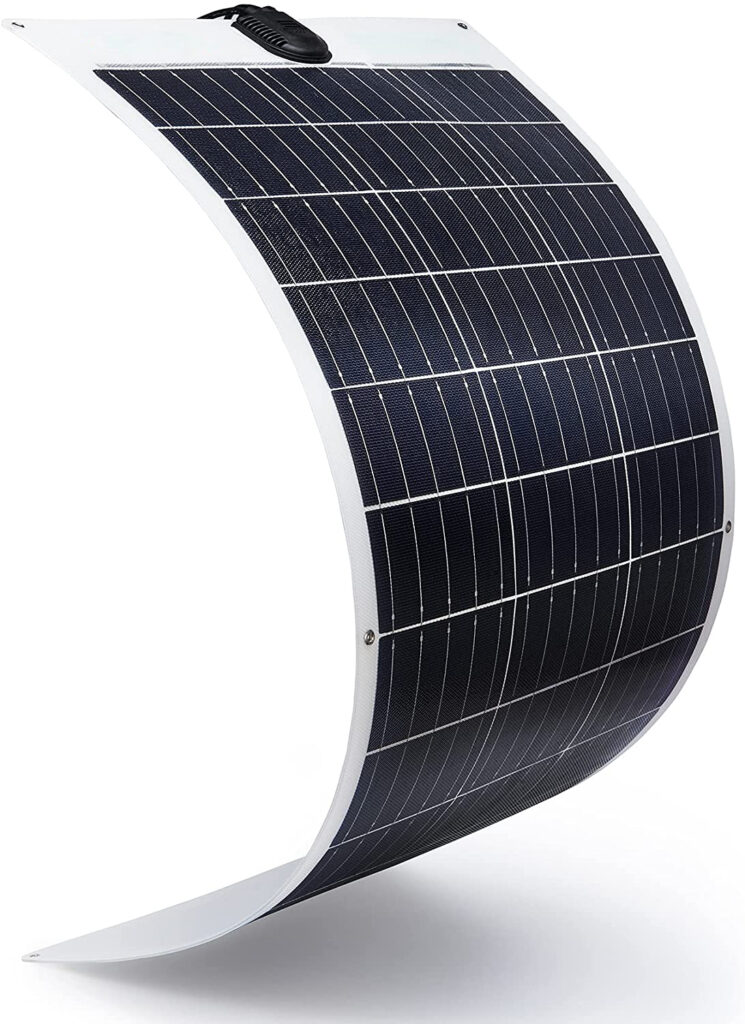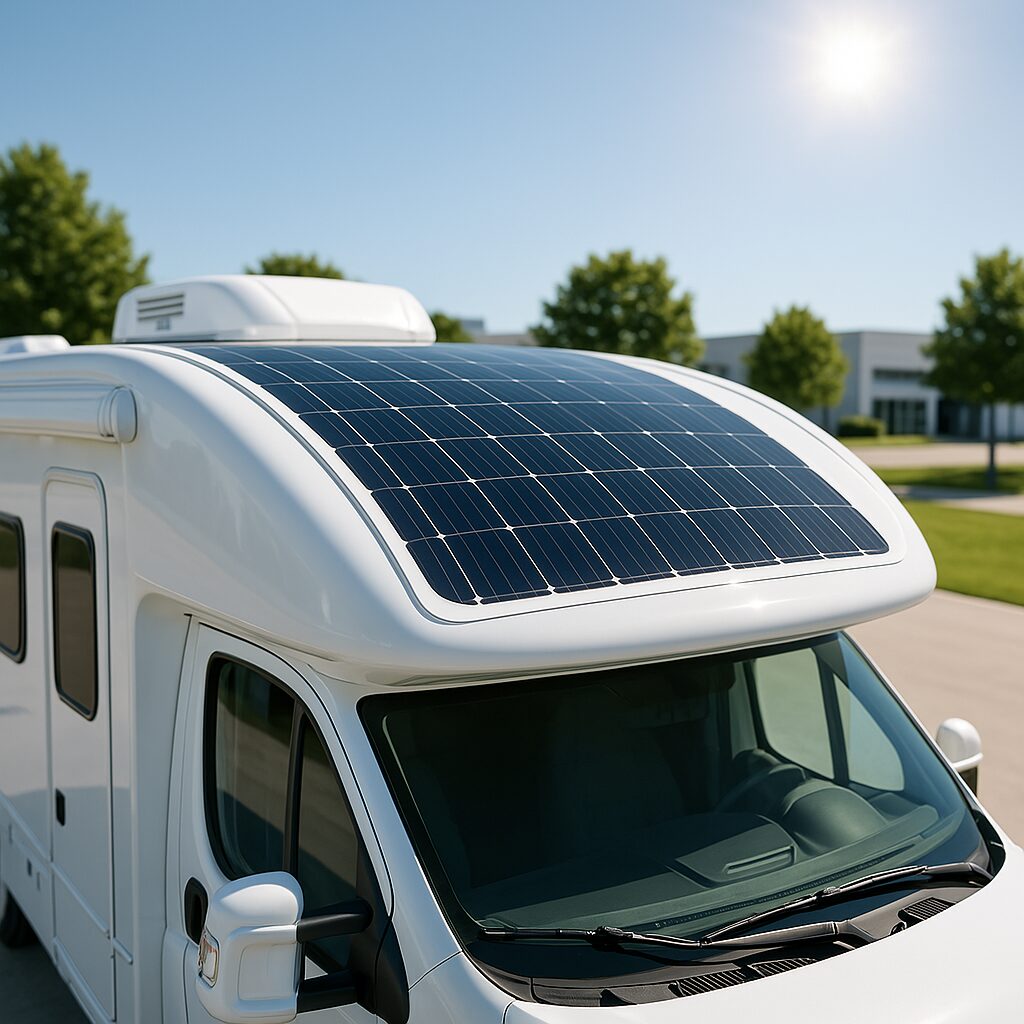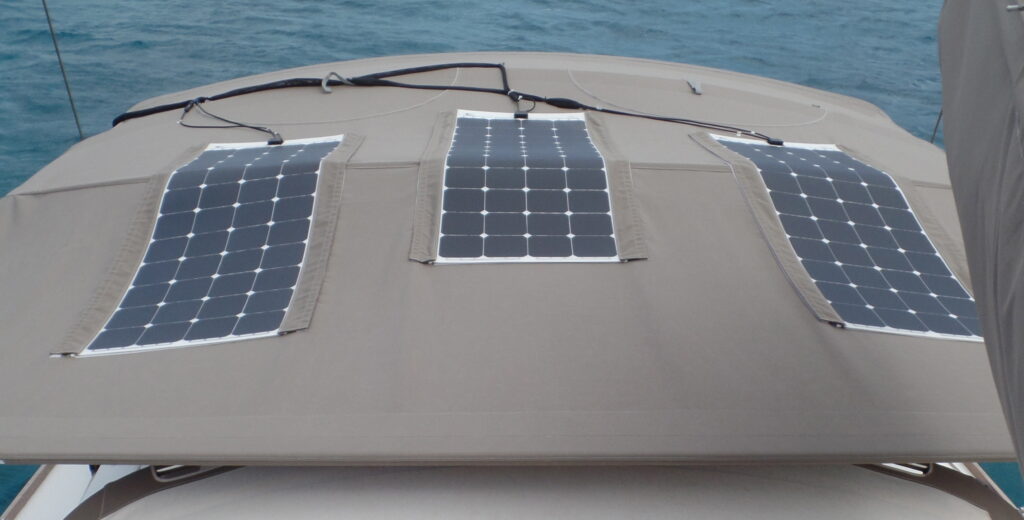Flexible solar modules are adaptable, lightweight panels that can be used where traditional solar panels can’t. This article explores how they work, their benefits and drawbacks, and key factors to consider when buying them.
Key Takeaways
- Flexible solar modules are lightweight and portable, allowing for easy installation on unconventional surfaces like RVs, boats, and even clothing.
- While flexible solar panels offer advantages like cost-effectiveness and adaptability, they typically have lower efficiency and shorter durability compared to traditional rigid panels.
- Key factors to consider when purchasing flexible solar modules include power output, efficiency, lifespan, and ease of installation, with emerging technologies promising improved performance in the future.

Modern technology has birthed the innovation of flexible solar modules, which are composed of exceptionally thin silicon cells. This attribute renders them both lightweight and easily transportable. Distinct from traditional rigid panels, their malleable design allows for adherence to a wide range of surfaces, thus expanding their application scope. The low weight of these sun energy collectors also plays a significant role in their adaptability.
Their innate capacity to mold around curved areas and fit into restricted spaces positions them as an excellent selection for non-standard mounting scenarios. The pliability offered by these panels ensures straightforward transportation and installation processes, establishing them as a convenient solution tailored to various energy requirements.
How Flexible Solar Modules Work
Flexible solar panels are crafted using ultra-thin silicon cells that are enclosed within layers of protective, durable plastic. These light materials provide the resilience needed for their function while preserving a lightweight design. The ability to bend and flex grants these panels exceptional adaptability to a variety of surfaces, in stark contrast to traditional rigid panels which require more elaborate mounting systems for installation.
Technological breakthroughs such as organic solar cells and graphene electrodes have been integrated into flexible solar panel designs like the LINKSOLAR! Such advancements not only heighten their pliability, but also boost how effectively they absorb sunlight. Their unique low-profile construction means they can seamlessly conform to almost any surface contour, including those with curves — all without needing bulky screws or mounts thanks to this streamlined approach during installation.
Continued innovation has led to developments like perovskite-silicon tandem solar cells, strategically layering different material types for maximum absorption of sunlight and heightened efficiency rates. As research progresses in creating advanced iterations of flexible solar technology, these improved panels stand as increasingly viable contenders in the evolving landscape of renewable energy solutions powered by the sun’s rays.
Applications of Flexible Solar Modules

Flexible solar panels are highly versatile, appropriate for a multitude of uses. For example, they can be installed on RVs to provide power for those who travel off-grid without compromising their need for electricity.
On marine vessels, these flexible solar panels integrate smoothly with the boat’s design, which is convenient for charging batteries and operating navigation systems. This not only conserves space, but also delivers a consistent flow of energy throughout extended sea journeys. The availability of foldable solar panel kits adds flexibility and convenience for campers looking to supply electrical power to gadgets, illumination solutions or even keep portable coolers running.
These innovative solar products aren’t restricted to large items. Advancements in technology have given rise to small-scale flexible solar options that tuck away into backpacks effortlessly—ideal companionship material during outdoor excursions. They’re progressively becoming part of various atypical surfaces such as clothing and backpack carriers thus broadening their range of applications.
LINKSOLAR stands out by offering an array of these adaptable panels specifically engineered for agricultural purposesas well as the maritime sectorand recreational vehicles (RVs), showcasing their adaptability across different fields.
Benefits of Using Flexible Solar Modules

Flexible solar panels provide several advantages, including:
- Their lightweight composition facilitates easy transport and installation across various locales.
- They are highly portable, a key feature for outdoor activities or traveling where traditional rigid panels would not be suitable.
- These flexible solar panels can be installed on many surfaces with minimal equipment needed, thus increasing their versatility.
These flexible solar designs weigh significantly less and have a thinner profile compared to conventional rigid panels. This reduced weight makes handling simpler and unlocks new application possibilities. Notably preferred for RVs and boats due to their efficient use of space, they also offer cost savings ideal for temporary installations or situations requiring low energy consumption without sacrificing the benefits derived from utilizing solar power.
The adaptable design characteristic of these flexible modules enables them to fit almost any surface shape or contour effortlessly. The flexibility offered by such design greatly expands options for installing these types of solar modules in areas unsuitable for fixed-positioned traditional counterparts. Collectively, this means that those who choose flexible units gain access to an exclusive blend of mobility, adaptability, and financial efficiency within the realm of harnessing solar energy.
Drawbacks of Flexible Solar Modules

Flexible solar panels come with several advantages, yet they face certain limitations. Their efficiency is Lower, ranging between 15% to 18%, in contrast to the often over 20% efficiency of conventional rigid panels. Due to this reduced efficiency, flexible panels tend not to produce as much electricity and may not be ideal for scenarios demanding high-energy output.
The durability of flexible solar technology also poses a challenge. Compared with traditional rigid counterparts, the materials utilized in flexible versions are usually less sturdy and thus more prone to damage as time goes on. When exposed to high temperatures for prolonged periods, their performance can diminish by about 10%-15% over ten years while standard rigid options typically handle heat better. Consequently reflecting these factors through shorter warranty periods – commonly around five years instead of the usual twenty-five seen with solid-state variations.
Maintenance demands for flexible panels can be greater due to their vulnerability against environmental elements stemming from softer construction materials used. The lifespan expectancy hinges heavily upon material quality. The ETFE-based ones outlast those made from PET (polyethylene terephthalate). Despite various benefits that make them appealing choices in some instances, it’s crucially important these considerations are factored into any decision-making processes regarding adopting flexibly designed solar solutions according to specific energy requirements.
Key Factors When Buying Flexible Solar Modules
When considering the acquisition of flexible solar panels, it is essential to assess several pivotal elements to make an informed decision that aligns with your requirements. The power capacity of these panels typically spans from 50 watts up to 300 watts, which assists in pinpointing a unit tailored to your energy needs.
It’s also vital to acknowledge the efficiency rates for flexible solar panel technology, found between 15% and 18%. Although this rate falls below what traditional rigid panels provide, understanding this metric will aid in setting accurate expectations for the amount of energy generated. Assessing the longevity expectancy of a flexible solar panel—often quoted as being anywhere from five years up through fifteen—is necessary because material robustness substantially impacts lifespan duration.
Finally, installation simplicity should be heavily weighted when choosing a product. It’s recommended you search for kits replete with straightforward instructions alongside all indispensable components required for effortless mounting. Confirming that a warranty backs your chosen product can offer additional assurance regarding its dependability. LINKSOLAR exemplifies such reliability by providing easy-to-install flexible solar solutions complete with detailed guidance and warranted support mechanisms.
Comparing Flexible Solar Modules with Traditional Rigid Panels

When assessing the differences between flexible solar panels and traditional rigid panels, it’s evident that there are several distinct characteristics to consider. Flexible panels often achieve an efficiency range from 15-18%, which falls short of the over 20% efficiency frequently found in rigid panels. Consequently, in scenarios where a high demand for electricity is present, flexible solar may not perform as effectively.
On the other hand, flexible solar offers numerous advantages when compared to its rigid counterparts. They tend to be more affordable at initial purchase, providing a cost-friendly alternative for budget-conscious individuals. Thanks to their lightweight construction and adaptability, they can be installed with ease on a variety of surfaces—including those that are curved—making them perfect for situations where using traditional stiff options would pose difficulties.
Despite this flexibility advantage, if we evaluate durability and long-term investment return, stiff-paneled systems have an edge due to their solid build quality and superior efficiency ratings. These ruggedly constructed models Outlast flexibles panel styles with warranties averaging between 25-30 years duration period. As such, deciding whether one should opt for pliable or inflexible variants rests heavily on individual specificities like resource allocation capability alongside desired utilization purposes.
Custom Solutions with Flexible Solar Modules
Flexible solar panels are noted for their adaptability, designed to meet the needs of specific applications. Their flexibility enables them to be configured into mini panels that perfectly fit in compact spaces, making them suitable for a myriad of specialized settings. LINKSOLAR specializes in creating custom mini solar panels that individuals can install with ease, delivering personalized energy solutions tailored to precise requirements.
These flexible solar modules can conform to an array of shapes and layouts, increasing their practicality across different settings. They come with customized design choices which include various connections and mounting options aimed at catering to distinct installation demands. Foldable solar panels exemplify this versatility as they are constructed to endure tough conditions while maintaining functionality even when parts of the panel might be compromised.
Resilience is a pivotal characteristic of these custom flexible solar units. They’re built strong enough to withstand challenging environments yet remain effortlessly portable due to their lightweight construction. LINKSOLAR caters specifically to commercial interests by offering customizable folding solar packages suitable for business-to-business (B2B) exchanges, thus providing adaptable energy solutions for diverse commercial uses.
Future Trends in Flexible Solar Module Technology
The potential for flexible solar panels is set to expand remarkably in the coming years, with expectations of significant market growth. Valued at $464 million in 2020, this sector could see its value almost double, reaching around $914 million by 2030. Enhancements in both efficiency and pliability are driving this advancement through dedicated research and development efforts.
Leading-edge innovations such as organic photovoltaic cells and graphene-based electrodes are spearheading progress, aiming to boost not only the flexibility but also the overall efficacy of these solar panels. Breakthroughs like perovskite-silicon tandem cells represent a leap forward. They merge distinct materials together achieving superior sunlight capture for more potent energy generation across various applications.
With ongoing technological advancements, we can anticipate an influx of even more adaptable and powerful flexible solar panel offerings on the market. The evolving landscape suggests that harnessing solar power will become increasingly viable for diverse uses ranging from individual consumer needs to expansive commercial ventures.
Summary
Flexible solar panels provide a combination of adaptability, portability, and cost-efficiency that render them suitable for diverse energy requirements. Although they may not be as efficient or durable as their traditional rigid counterparts, the advantages they offer frequently surpass these shortcomings in certain uses. With ongoing advancements in technology, it is anticipated that flexible solar modules will become progressively significant contributors to the field of renewable energy.
Frequently Asked Questions
What are flexible solar panels made of?
Flexible solar panels are primarily made of ultra-thin silicon cells and protective plastic layers, with some incorporating organic solar cells and graphene electrodes for improved flexibility.
This combination allows them to be lightweight and adaptable for various surfaces.
How efficient are flexible solar panels compared to traditional rigid panels?
Flexible solar panels are generally less efficient than traditional rigid panels, with an efficiency range of 15-18% compared to over 20% for rigid panels.
This makes traditional panels a more effective choice for maximizing energy output.
Can flexible solar panels be used on boats and RVs?
Absolutely, flexible solar panels are perfect for boats and RVs as their lightweight and adaptable design allows for easy mounting on curved surfaces.
This makes them an excellent choice for harnessing solar energy while on the move.
What factors should I consider when buying flexible solar panels?
When buying flexible solar panels, consider power output, efficiency (typically 15-18%), lifespan, installation ease, and warranty.
These factors will help ensure you select a reliable and effective solar solution.
What are the future trends in flexible solar panel technology?
Future trends in flexible solar panel technology focus on improved materials such as organic solar cells and graphene electrodes, alongside the emergence of efficient perovskite-silicon tandem cells.
This sector is set for substantial growth, with projections indicating a market value of $914 million by 2030.


















